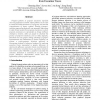200 search results - page 13 / 40 » What Graphs can be Efficiently Represented by BDDs |
ICTAI
2008
IEEE
14 years 1 months ago
2008
IEEE
Frequent patterns in program executions represent recurring sequences of events. These patterns can be used to reveal the hidden structures of a program, and ease the comprehensio...
WEBDB
2010
Springer
13 years 5 months ago
2010
Springer
The Semantic Web, which represents a web of knowledge, offers new opportunities to search for knowledge and information. To harvest such search power requires robust and scalable ...
SIGMOD
2008
ACM
14 years 7 months ago
2008
ACM
Data lineage and data provenance are key to the management of scientific data. Not knowing the exact provenance and processing pipeline used to produce a derived data set often re...
AOSD
2007
ACM
13 years 11 months ago
2007
ACM
Inspired by our past manual aspect mining experiences, this paper describes a random walk model to approximate how crosscutting concerns can be discovered in the absence of domain...
JMLR
2008
13 years 7 months ago
2008
Causal reasoning is primarily concerned with what would happen to a system under external interventions. In particular, we are often interested in predicting the probability distr...

